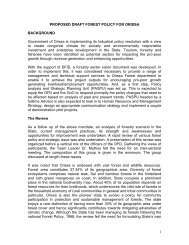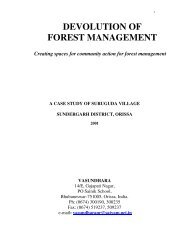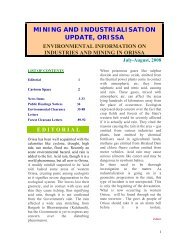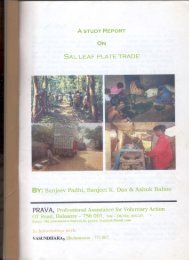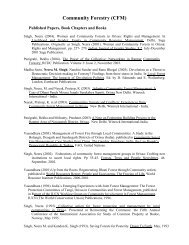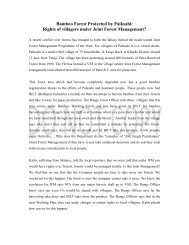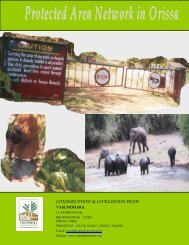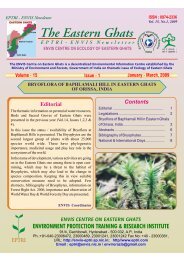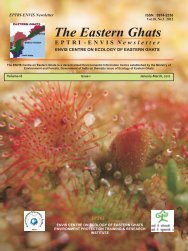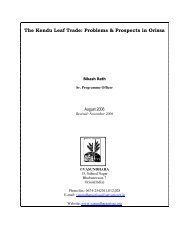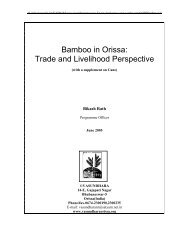Download Status Of Sponge Iron Units In Orissa - Vasundhara
Download Status Of Sponge Iron Units In Orissa - Vasundhara
Download Status Of Sponge Iron Units In Orissa - Vasundhara
Create successful ePaper yourself
Turn your PDF publications into a flip-book with our unique Google optimized e-Paper software.
ENVIRONMENTAL IMPACT OF SPONGE IRON UNITSRight from the raw material yard to disposal of the final product (<strong>Sponge</strong> <strong>Iron</strong>), at every step of itshandling there is pollution. <strong>Sponge</strong> <strong>Iron</strong> Plants have the following pollution hazards:1. Dust emission during raw material preparation and product discharge and handling:A definite size of iron ore and coal is required for the production of sponge iron. Thesuppliers are not adequately equipped to cater to the needs of the sponge iron industries.Therefore, the industries crush and size the raw materials at their plant premises. Duringsuch crushing and sizing operations, generation of fugitive dust and discarded ore fines andcoal fines in inevitable. Major dust emitting areas include areas such as product dischargefrom cooler to conveying system, magnetic separator, and raw material preparation unit.2. Reduction: The gaseous products of reduction contain mainly raw material dust, and gaseslike CO 2 , CO, H 2 , NO X , O 2 , unreacted hydrocarbons, and SO X3. Waste water discharge: The dusts from the gaseous emissions are separated through ESPor Gas quenching system. <strong>In</strong> either case, the disposal is done by converting the dust to aslurry form to avoid flying of the same in ambient air. <strong>In</strong> order to recycle the water, theslurry is allowed to settle in a clari-flocculator, from where the settled solid particles arepumped out. The polluted slurry water is then allowed to settle in settling ponds, or lagoonsfrom where the clear water is pumped back for reuse. Such water is polluted with dissolvedsolids.4. Gaseous emissions: The exhaust gas emerges out of DRI kilns at a temperature of about900°C having some quantities of combustibles. This gas is used to produce steam in wasteheat boilers, which in turn is used to produce power. The dust coming from exhaust gas iseither quenched to make slurry for easy disposal or is collected in dry condition or in wetcondition from the ESP. So far, no utilization of this dust have been found out which causesair pollution (due to dust) in the near by areas.5. Char: The partially burnt coal called char is discharged from the reactor along with spongeiron. After the magnetic separation, the char is separated as waste.PROBLEMS DUE TO SPONGE IRON UNITS IN ORISSA<strong>In</strong> many of the sponge <strong>Iron</strong> <strong>Units</strong> in <strong>Orissa</strong>, ESP has not been installed and where it is installed,these units switch off their ESPs during the nights for a few hours. Thus, the area becomes a hugesmoke bowl. <strong>In</strong> some sponge iron units in Sundergarh, it was found that the precipitators were notrunning in several of the units. Smoke and soot from the plants carried by the wind cause wheezingproblem in kids, and cows and cattle to become restless. The smoke is sometimes so thick thatvision even at a distance as close as 1 meter becomes difficult. The clothes worn by peopleimmediately become smeared with coal dust. Even cooking utensils are covered with soot. <strong>In</strong>Kormunda (Sundergarh) where Neepaz Metallics (a 1.4 lakh tonnes sponge iron plant) is set up, thedrinking water becomes covered with black soot. The emissions also cause irritation and wateringof eyes in human beings.



